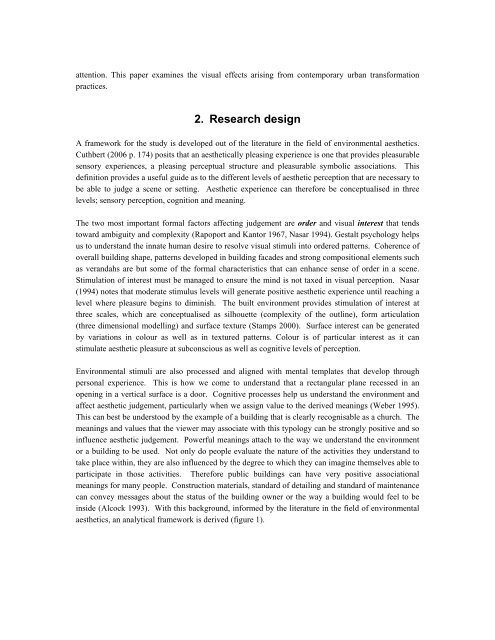Visual Aesthetic Perception and Judgement Of Urban Streetscapes
Visual Aesthetic Perception and Judgement Of Urban Streetscapes
Visual Aesthetic Perception and Judgement Of Urban Streetscapes
Create successful ePaper yourself
Turn your PDF publications into a flip-book with our unique Google optimized e-Paper software.
attention. This paper examines the visual effects arising from contemporary urban transformationpractices.2. Research designA framework for the study is developed out of the literature in the field of environmental aesthetics.Cuthbert (2006 p. 174) posits that an aesthetically pleasing experience is one that provides pleasurablesensory experiences, a pleasing perceptual structure <strong>and</strong> pleasurable symbolic associations. Thisdefinition provides a useful guide as to the different levels of aesthetic perception that are necessary tobe able to judge a scene or setting. <strong>Aesthetic</strong> experience can therefore be conceptualised in threelevels; sensory perception, cognition <strong>and</strong> meaning.The two most important formal factors affecting judgement are order <strong>and</strong> visual interest that tendstoward ambiguity <strong>and</strong> complexity (Rapoport <strong>and</strong> Kantor 1967, Nasar 1994). Gestalt psychology helpsus to underst<strong>and</strong> the innate human desire to resolve visual stimuli into ordered patterns. Coherence ofoverall building shape, patterns developed in building facades <strong>and</strong> strong compositional elements suchas ver<strong>and</strong>ahs are but some of the formal characteristics that can enhance sense of order in a scene.Stimulation of interest must be managed to ensure the mind is not taxed in visual perception. Nasar(1994) notes that moderate stimulus levels will generate positive aesthetic experience until reaching alevel where pleasure begins to diminish. The built environment provides stimulation of interest atthree scales, which are conceptualised as silhouette (complexity of the outline), form articulation(three dimensional modelling) <strong>and</strong> surface texture (Stamps 2000). Surface interest can be generatedby variations in colour as well as in textured patterns. Colour is of particular interest as it canstimulate aesthetic pleasure at subconscious as well as cognitive levels of perception.Environmental stimuli are also processed <strong>and</strong> aligned with mental templates that develop throughpersonal experience. This is how we come to underst<strong>and</strong> that a rectangular plane recessed in anopening in a vertical surface is a door. Cognitive processes help us underst<strong>and</strong> the environment <strong>and</strong>affect aesthetic judgement, particularly when we assign value to the derived meanings (Weber 1995).This can best be understood by the example of a building that is clearly recognisable as a church. Themeanings <strong>and</strong> values that the viewer may associate with this typology can be strongly positive <strong>and</strong> soinfluence aesthetic judgement. Powerful meanings attach to the way we underst<strong>and</strong> the environmentor a building to be used. Not only do people evaluate the nature of the activities they underst<strong>and</strong> totake place within, they are also influenced by the degree to which they can imagine themselves able toparticipate in those activities. Therefore public buildings can have very positive associationalmeanings for many people. Construction materials, st<strong>and</strong>ard of detailing <strong>and</strong> st<strong>and</strong>ard of maintenancecan convey messages about the status of the building owner or the way a building would feel to beinside (Alcock 1993). With this background, informed by the literature in the field of environmentalaesthetics, an analytical framework is derived (figure 1).



